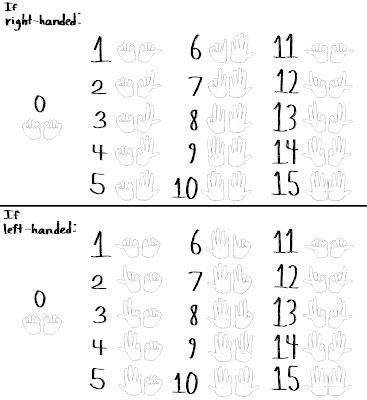"...predominantly, Dayir's societies conducts business and lifestyle using a pentadecimal numeral system. Written in similarly ubiquitous Atiwana numerals, the pentadecimal system has a role parallel to Western society's Hindu-Arabic decimal numeral system. While neither system obviously counts like the other, both systems do at least originate from finger-counting. Earthly decimal societies may have simply converged upon the man's ten corporeal fingers. However, ████ legendarily suggested that ancient Dayirese societies concluded further along their belief in three-handed divinity. Though "flawed" for having simply two hands, so ████ says, ancient Dayirese humans anticipated a greater connection to divine "perfectitude" for managing to count up to fifteen as if humans had three hands.
Produced henceforth were the pan-Dayirese pentadecimal system and associated gestures, as depicted in Figure 1. As shown, not only does counting conflate itself with Dayirese conceptions of holy trialism, long-standing Dayirese preconceptions about handedness (ultimately corollary to holy trialism) also manifest as different counting "orientations" for left-handed and right-handed people. Poetically, it is only when humans count toward fifteen from ten– along the holy third hand– that lefties and righties finally coincide. Is it not apparent that the gesture for fifteen– distinguished from the gesture of ten– has out-stretched hands pressed together in virtuous offering? It is apparent, should we ever be able to ask the likes of ████ or ████.
FIGURE 1. Orientations for pan-Dayirese pentadecimal counting based on human user's handedness.
Per Dr. Catalino G. Vance (2022)'s recommendations, such a system can be rendered in our numeral system as organized in FIGURE 2, where letters A-E represent the five additional pan-Dayirese numerals, if for nothing else than to create an analogy.
FIGURE 2. Pan-Dayirese numerals rendered in Hindu-Arabic alongside their actual Hindu-Arabic equivalent.
Usage of pentadecimal numerals and the actual written Atiwana numerals to represent them are both widespread and used cross-linguistically across Dayir along the same ranges as holy trialism..."


